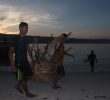Atrocities in the Philippines
In relation to large-scale war crimes and crimes against humanity, the doctrine was cited in the trial and execution of General Tomoyuki Yamashita for atrocities committed in the Philippines by Japanese forces under his command during World War II. Yamashita, who was in command of the 14th Area Army of Japan in the Philippines, was found by the U.S. Military Tribunal guilty of atrocities committed by his troops against thousands of Filipino civilians.
The first to comprehensively codify the doctrine of command responsibility was the Additional Protocol I (AP I) of 1977 to the Geneva Conventions of 1949. AP I clarifies that crimes committed by a subordinate does not absolve his superiors from responsibility �if they knew� or �had reason to know� about the commission and did nothing to prevent any breaches of the Convention. Based on Article 86 of AP I, it has been interpreted that command responsibility extends as high as any officer in the chain of command who knows or has reason to know that his subordinates are committing war crimes and fails to act to stop them.
This principle was subsequently upheld by the International Criminal Tribunal for the former Yugoslavia (ICTY, formed in 1993) in a number of cases it tried from 1998-2001. In the Prosecutor vs Blastic case, the tribunal referred to the International Committee for the Red Cross Commentary to AP I which asserts that �ignorance cannot be a defense (if) the absence of knowledge is the result of negligence in the discharge of (the commander�s) duties.� In the same vein, Article 28 of the Rome Statute of the International Criminal Court (ICC, 1998) imposes individual responsibility on military commanders for crimes committed by forces under their command and control if they �either knew or, owing to the circumstances at the time, should have known that the forces were committing or about to commit such crimes.�
On the international level, the doctrine of command responsibility clearly has been extended to civilian authorities exercising control over military forces. Referring back to the post-World War II prosecutions in Nuremberg and Tokyo, a number of civilian authorities were convicted of war crimes. Two of the most prominent examples are Japanese Prime Minister Hideki Tojo, who was a former military commander, and Foreign Minister Koki Hirota. Their civilian cloak did not prevent the International Criminal Tribunal for the Far East in holding them criminally liable for the atrocities committed by the Japanese military.
More recently, the ICTY and the International Criminal Tribunal for Rwanda (ICTR) have held civilians criminally liable for the actions of military forces under their control. At the ICTR in 1998, former Rwandan Prime Minister Jean Kambanda pled guilty to six criminal counts, including genocide and crimes against humanity. He is now serving a life sentence for these crimes. These rulings underscore the coverage of command responsibility to include the key role civilian officials and political leaders play in the commission of atrocities during an armed conflict.
Command responsibility is determined not just by rank but also by subordination, under which top civilian authorities can be pinned down. Iavor Rangelov and Jovan Nicic (Command Responsibility: The Contemporary Law, Humanitarian Law Center, 2004) point to four layers of legal command covered by the principle: policy command (heads of state, high-ranking government officials); strategic command (war cabinet, chiefs of staff); operational command; and tactical command (direct command over troops on the ground).
Arroyo
Thus in the Philippines, at least three legal luminaries believe that President Arroyo cannot insulate herself from responsibility over the extra-judicial killings and abductions. One of them, Judge Silvino Pampilo, Jr., of Manila RTC Branch 26 said late June that as commander in chief of the AFP, Mrs. Arroyo was also covered by the principle of command responsibility. He clarified though that she would be liable �only after she steps down from office.�
�Responsibility for summary executions or disappearances extends beyond the person or persons who actually committed these acts,� Pampilo, Jr. said. �Anyone with higher authority who authorized, tolerated or ignored these acts is liable for them.�
The judge, who will preside over one of the special tribunals authorized by Chief Justice Puno to handle extrajudicial killings, also said the tribunals may use the doctrine to hold military commanders and police officers criminally liable for their subordinates� actions.
He cited Section 1 of EO 226 (Feb. 17, 1995), which states: �Any (AFP) officer shall be held accountable for neglect of duty under the doctrine of command responsibility, if he has knowledge that a crime or offense shall be committed, is being committed, or has been committed by his subordinates, or by others within his area of responsibility and, despite such knowledge, he did not take preventive or corrective action either before, during or immediately after its commission.� In the absence of any law under which the commander may be held criminally liable, the command responsibility doctrine may be used, he added.
Raul Pangalangan, former dean of the University of the Philippines� College of Law, agrees: �The President may be held to account, whether as head of state under state responsibility, or as commander in chief under individual criminal responsibility.� In his Inquirer column (�Passion for Reason,� June 29, 2007), he wrote that the 1998 Rome Statute�s codification of command responsibility is an authoritative statement of �customary international law� which, under the Philippine Constitution�s �incorporation clause� is deemed �part of the law of the land.�
Analysis, Extrajudicial Killings









